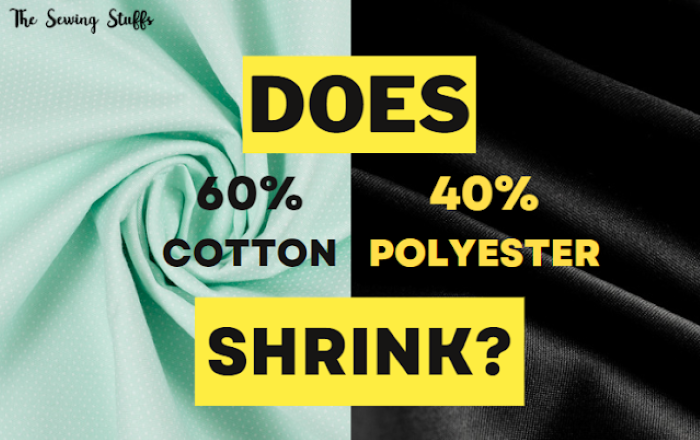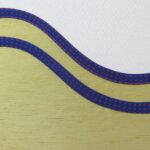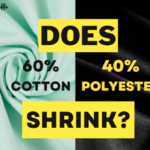In this post I will answer the question Does 60 cotton 40 polyester shrink? I’ll explain why cotton shrinks and why polyester does not shrink. Cotton is a natural fiber and polyester is a synthetic fiber. Cotton shrinks because it is made from a long, thin fiber. Polyester does not shrink because it is made from short, thick fiber. Let us move further and discuss all the things in detail.
Yes, 60 cotton and 40 polyester shrinks. A blend of 60% cotton and 40% polyester may experience some shrinkage when exposed to heat and moisture, particularly if it is not properly cared for during washing and drying. The amount of shrinkage can vary depending on several factors, including the quality of the fabric, the specific cotton and polyester fibers used, and the conditions of the washing and drying process.
Overall, a blend of 60% cotton and 40% polyester is less prone to shrinkage than pure cotton, but it is still essential to take proper care of the fabric to prevent any potential shrinkage.
Cotton is a natural fiber that comes from the cotton plant’s seed pod. It has been used for thousands of years to make textiles and clothing. Cotton is 100% organic fabric.
Cotton is known for its softness, breathability, and comfort, as well as its ability to absorb moisture and wick away sweat. It is also strong and durable. It can withstand frequent washing and use.
Polyester is a synthetic fiber that is made from a type of plastic called polyethylene terephthalate (PET). It was first invented in the 1940s and has since become one of the most widely used fibers in the world.
Polyester has several unique properties that make it desirable for use in clothing, textiles, and other products. It is lightweight, strong, and durable. It resists wrinkling, shrinking, and stretching. It is also quick-drying and moisture-wicking, which makes it popular for use in athletic and outdoor clothing.
To understand why cotton and polyester are blended you must know the difference between them. These two different types of fibers are commonly used in clothing and textile manufacturing. Here are some of the key differences between cotton and polyester:
| Cotton | Polyester |
| Cotton is a natural fiber | Polyester is a synthetic fiber |
| Cotton is soft, breathable, and comfortable to wear | Polyester is not as breathable as cotton. It feels less comfortable to wear in hot and humid conditions |
| Cotton is prone to shrinking, wrinkling, and fading over time | Polyester is generally more durable than cotton. It does not change its shape or color |
| Cotton requires care to avoid shrinking or melting in high temperature | Polyester is easy to care for |
| It is made from renewable sources | It is made from non-renewable sources |
| It is a biodegradable and more sustainable choice | It is not biodegradable |
The key difference between cotton and polyester
Yes, cotton can shrink when it is washed and dried. to minimize shrinkage in cotton clothing or textiles, it is recommended that you follow the care instructions on the label. Avoid over-drying or over-washing the fabric, which can cause additional shrinkage.
Some manufacturers may pre-shrink cotton fabrics before they are sold, which can help to reduce further shrinkage. However, even pre-shrunk cotton can still shrink to some extent, especially if it is exposed to high heat or mechanical agitation during washing and drying.
Cotton fiber has a rough structure, so it naturally tends to contract when exposed to heat and moisture.

The amount that cotton shrinks depends on several factors, including the type of cotton, the weave of the fabric, the way it is washed and dried, and the temperature of the water used. In general, cotton can shrink by up to 5-10% when it is washed and dried in hot water and put in the dryer on a high heat setting.
You can minimize the shrinking of cotton by washing it in cold water, drying it on a low heat setting, or air-drying it instead of putting it in the dryer.
Polyester is a synthetic fiber that is generally resistant to shrinkage. Unlike natural fibers such as cotton, polyester does not have a natural tendency to contract when exposed to heat and moisture.
Polyester is known for being a relatively stable and durable fiber that does not shrink easily. Unlike natural fibers like cotton or wool, polyester does not have a tendency to shrink.
“60 cotton and 40 polyester” refers to a blend of two different fibers commonly used in clothing and textile manufacturing. It means that the fabric or material is made up of 60% cotton and 40% polyester fibers.
A blend of 60% cotton and 40% polyester is made by combining cotton and polyester fibers during the textile manufacturing process. Here are the basic steps involved in creating a fabric with this blend.“`
- Step 1. Fiber Selection: The cotton and polyester fibers used in the blend are selected based on their quality and characteristics.
- Step 2. Blending: The cotton and polyester fibers are blended together in 60/40 proportions to create a uniform blend. The blending process can be done using various methods, including carding, drawing, and roving.
- Step 3. Spinning: Once the fibers are blended, they are spun into yarns. The yarns may be spun using different methods depending on the desired characteristics of the fabric.
- Step 4. Weaving or Knitting: The yarns are then woven or knitted together to create the fabric.
- Step 5. Finishing: After the fabric is created, it goes through a finishing process, which can include treatments such as dyeing, printing, or coating.
The cotton-polyester blend is made because it combines the best characteristics of both fibers. Cotton is a natural fiber that is soft, breathable, and comfortable to wear. It can wrinkle and shrink easily and may not be as durable as synthetic fibers. Polyester is a synthetic fiber that is strong, durable, and resistant to wrinkles and shrinking. It is less comfortable to wear and less breathable than natural fibers.
By blending cotton and polyester in a 60/40 ratio, you can create a fabric that has the softness, comfort, and breathability of cotton, along with the strength, durability, and wrinkle resistance of polyester.
To take proper care of clothing or textiles made from a 60% cotton and 40% polyester blend, there are a few precautions to keep in mind. Follow these precautions while washing your stuff.
- Follow the care instructions on the label: The care instructions on the label of the garment or textile provide guidance on how to properly wash, dry, and care for the fabric. By following these precautions, you can help to ensure that clothing or textiles made from a 60% cotton and 40% polyester blend remain in good condition and retain their shape and fit.
- Wash in cool or warm water: To minimize shrinkage, it is recommended to wash the fabric in cool or warm water, rather than hot water. Hot water can cause the cotton fibers to shrink, which may affect the shape and fit of the garment.
- Tumble dry on low heat or air-dry: When drying the fabric, it is important to avoid high heat, which can cause the polyester fibers to melt or shrink. Instead, tumble dry on low heat or air-dry to prevent damage to the fabric.
- Avoid over-drying or over-washing: Over-drying or over-washing the fabric can cause damage or shrinkage, so it is important to avoid these practices. Remove the fabric from the dryer promptly once it is dry, and do not wash the fabric more frequently than necessary.
Some common natural fibers are known to shrink when exposed to heat and moisture. These fibers include:
- Cotton: Cotton is a natural fiber that is prone to shrinkage when exposed to heat and moisture. Cotton fibers can contract and distort when washed and dried at high temperatures, causing garments to shrink and lose their shape.
- Wool: Wool is another natural fiber that is known to shrink when exposed to heat and moisture. Wool fibers can become matted and compressed when washed in hot water or agitated too vigorously, leading to shrinkage and distortion of the fabric.
- Silk: Silk is a delicate natural fiber that can shrink when exposed to water or heat. To prevent shrinkage, silk garments should be hand washed in cool water and air-dried.
- linen: Linen can shrink. Linen is a natural fiber that is made from the flax plant and it has a tendency to shrink.
There are several synthetic fibers that are known to be resistant to shrinkage, including.
- Polyester: Polyester is a synthetic fiber that is highly resistant to shrinkage. It can be washed and dried at high temperatures without significant shrinkage or distortion.
- Nylon: Nylon is another synthetic fiber that is resistant to shrinkage. It is durable and can withstand high heat without significant damage.
- Acrylic: Acrylic is a synthetic fiber that is often used as a substitute for wool. It is resistant to shrinkage and can be machine washed and dried without significant distortion.
- Rayon: Rayon is a semi-synthetic fiber that is made from cellulose. While it can shrink if exposed to high heat or moisture, it is generally less prone to shrinkage than natural fibers like cotton or wool.
A blend of 60% cotton and 40% polyester is a popular choice for clothing and textiles, as it combines the softness and breathability of cotton with the durability and wrinkle resistance of polyester. However, there are several alternative materials that can be used to achieve similar properties and characteristics.
- Cotton-polyester-rayon blend: This blend combines cotton, polyester, and rayon to create a soft, durable, and breathable fabric that is often used for casual clothing and athletic wear.
- Cotton-nylon blend: A blend of cotton and nylon can provide a similar level of durability and wrinkle resistance as cotton-polyester, while also offering increased strength and abrasion resistance.
- Hemp-cotton blend: A blend of hemp and cotton can provide a sustainable and eco-friendly alternative to cotton polyester. Hemp fibers are strong and durable and can help to increase the strength and durability of the fabric.
- Bamboo-cotton blend: A blend of bamboo and cotton can provide a soft, lightweight, and breathable fabric that is often used for activewear and casual clothing.
Cotton and polyester can be blended in a variety of different proportions, and the specific blend used will depend on the desired properties of the fabric or product.
Here are some common cotton-polyester blends:
- 50/50 cotton polyester: This is a popular blend that is commonly used for t-shirts, sweatshirts, and other casual apparel. It offers a good balance of softness, durability, and moisture-wicking properties.
- 60/40 cotton-polyester: This blend is also commonly used for clothing and is particularly popular for dress shirts and blouses. It has a softer hand than a 50/50 blend and is more breathable.
- 80/20 cotton-polyester: This blend has a higher percentage of cotton and is often used for lightweight, breathable fabrics like summer dresses and blouses.
- 65/35 cotton-polyester: This blend is often used for workwear and uniforms, as it combines the durability and moisture-wicking properties of polyester with the softness and breathability of the cotton.
- 35/65 cotton-polyester: This blend has a higher percentage of polyester and is often used for bedding and other household textiles, as it is more resistant to wrinkling and staining than pure cotton.
If you are going to purchase this fabric then you must read all advantages and disadvantages of this fabric.
Durability: The polyester in the blend gives the fabric strength and resistance to tearing, shrinking, and wrinkling, making it more durable than pure cotton fabrics.
- Easy care: The polyester in the blend makes it easy to care for, as it is less prone to wrinkles, shrinking, and fading, and can be machine washed and dried.
- Breathable: The cotton in the blend makes it breathable and comfortable to wear, especially in warmer weather.
- Cost-effective: Compared to pure cotton or other natural fiber fabrics, 60 cotton 40 polyester blend can be more cost-effective, making it a popular choice for mass-produced clothing.
- Absorbency: The polyester in the blend reduces the fabric’s ability to absorb moisture, which can make it less comfortable to wear in humid weather.
- Appearance: The blend may not have the same visual appeal as a pure cotton fabric, as the polyester fibers can give it a shinier or more synthetic appearance.
- Environmental concerns: Polyester is a synthetic material made from petrochemicals, which raises environmental concerns due to its non-biodegradable nature and reliance on non-renewable resources.
- Heat sensitivity: The polyester in the blend can be sensitive to high temperatures, which can cause it to melt or distort if exposed to high heat from an iron or dryer.
In conclusion, 60% cotton and 40% polyester is a popular combinations in the industry. It offers a good balance of comfort and durability. In fact, this fabric blend is one of the most popular choices for apparel like shirts, pants, and jackets. It also has a good reputation for being durable, washable, and comfortable.
If you are looking for a long-lasting quality fabric that won’t fade easily and won’t wrinkle easily, then cotton/polyester is a great choice. If you are looking for something that is a little more affordable, then you may want to consider 100% cotton. If you are looking for something that is a little more durable, then you may want to consider 100% polyester.
A blend of 60% cotton and 40% polyester can be created by combining the two fibers during the spinning process. The cotton and polyester fibers are typically first separated and then carded, which means that they are combed to remove any impurities and to align the fibers in a parallel orientation.Once the fibers are carded, they are blended together in the desired proportions, in this case, 60% cotton and 40% polyester. The blended fibers are then spun into yarn using spinning machines, which twist the fibers together to create a strong, continuous strand of yarn.
The yarn is then woven or knit into fabric, which can be used to create a wide range of products, from clothing and bedding to towels and upholstery. A blend of 60% cotton and 40% polyester is a popular choice for many products, as it combines the softness and breathability of cotton with the durability and wrinkle resistance of polyester, creating a fabric that is comfortable, durable, and easy to care for.











